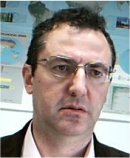|
Plenary Lecture
From Industrial to
Postindustrial Landscapes –
Brownfield Reuse in Shrinking Cities

Professor Thomas Panagopoulos
Centro de Investigacao sobre Espaco e Organizacoes (CIEO)
Faculdade de Ciencias e Tecnologia
Universidade do Algarve, Campus de Gambelas, 8005-139, Faro
PORTUGAL
E-mail: tpanago@ualg.pt
Abstract: In last decades, the phenomenon of shrinking cities has
many examples in most developed countries. According to Wiechmann (2008) 54%
of the European cities lost population in the period from 1996 to 2001. The
phenomenon of urban shrinkage is based on several processes of
transformation. The number and aggregate size of brownfield sites in the
cities of Europe is increasing. In many developed countries, which in past
decades have experienced the impact of shrinkage processes, the essential
causes have been suburbanization, deindustrialization, demographic
shrinkage, and post-fordist transformations. Lisbon is in the 10 cities with
the highest relative loss of more than 1.75% annually. Old industrialized
cities (typical examples are Glasgow, St. Etienne, or Gelsenkirchen) has led
to shrinking, in some ways similar to those in American metropolises like
Detroit, Pittsburgh, and Cleveland. This is particularly the case of Eastern
Europe, where the combination of post-socialist and post-fordist
transformation processes led to exceptionally severe shrinkage phenomena.
Certainly, urban shrinkage as such is not a new phenomenon and according to
Beauregard (2003) is inseparable from the history of the city. Numerous
studies have analysed its manifestations and causes and the development and
decline of cities has been viewed as a natural process whereby urban change
results from a life cycle that ends in inevitable decline Van den Berg, L.
et al. (1982), that may pass from can be seen to go through four successive
development stages: urbanisation, suburbanisation, de-urbanisation and re-urbanisation.
Derelict and contaminated industrial sites are unrealized resources for
initiating urban regeneration and ecological restoration. These sites are
often in advantageous locations near city centers, situated along waterways,
supported by existing infrastructure, and adjacent to residential
communities. These Landscapes are environmentally impaired assets that need
to be returned to productive use, and reintegrated into the surrounding
community. The shrinking city syndrome is leaving planners and city
officials with, among other things, the challenge of preserving and reusing
buildings with architectural and cultural interest. To exemplify the
importance of those spaces in the urban landscape, this presentation will
analyze two industrial landscape reclamation projects realized in Portugal
during the last decade (Parque Tejo-Trancao-Expo 98 and Braga Stadium-Euro
2004) and compare them with other examples from around the world. The
significance of those projects to achieve a sustainable urban landscape is
discussed. This presentation will show that the industrial landscape should
be viewed as a resource and its recovery as an opportunity to develop new
multi-functional landscapes.
Brief Biography of the Speaker:
Profesor Thomas Panagopoulos received the B.Sc. in Forestry from Aristotle
University, the M.Sc. in Renewable Natural Resources from the Mediterranean
Agronomic Institute, the Ph.D. from Faculty of Geosciences Aristotle
University. The area of his PhD is landscape reclamation. He has published
more than 120 papers in Journals and Conferences.
Thomas Panagopoulos is a faculty member in the Landscape Architecture
department at the Faculty of Cience and Technology at the University of
Algarve, Portugal where he has been Department Head and Landscape
Architecture Degree Director, and presently coordinating research works on
natural, rural and industrial landscape management and reclamation. He is
Invited Academic Lecturer in various Universities and Research Organizations
like: Michigan Sate University USA, Huelva University Spain, Aristotle
University Greece.
He is Fellow of the International Union of Forest Research Organization (IUFRO),
of the Global Network for Environmental Science and Technology (GlobalNEST),
the WSEAS (The World Scientific and Engineering Academy and Society), the
European Network for Research on Desertification (DesertNet) and the
American Society of Mining and Reclamation (ASMR).
In 2007 he founded a new research unit in the University of Algarve: Centro
de Investigacao sobre Espaco e Organizacoes (CIEO) with 19 PhD members. He
is member of the Executive Committee of the CIEO and leader of the “Spatial
Organization and Sustainability” which was recently evaluated as very good
from international panel.
|